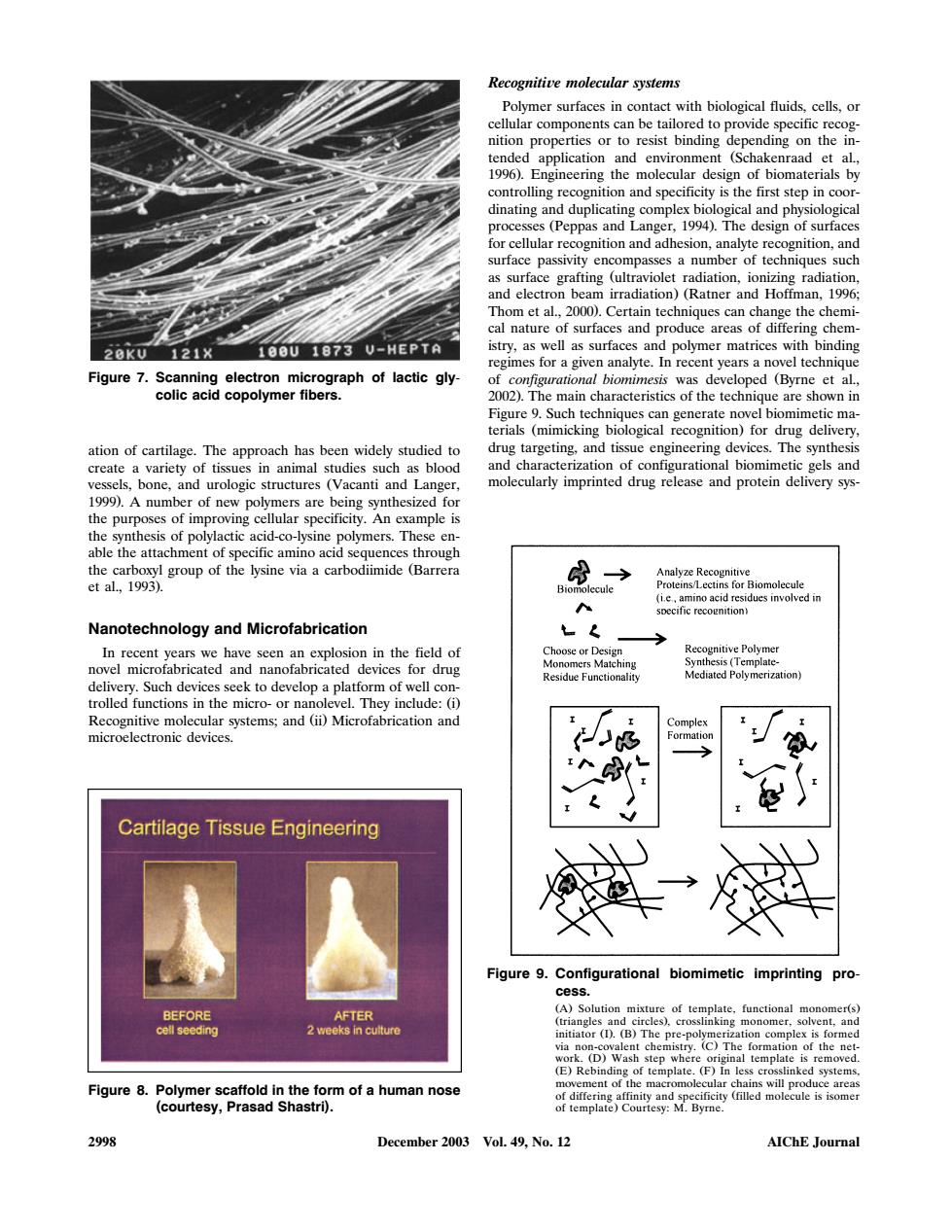正在加载图片...

Recognitive molecular systems Polymer surfaces in contact with biological fluids,cells,or application and environm ace pa an,1996 121 190U 1873 U-HEPTA Figure 7.Scanning electron micrograph of lactic gly- Was leveloped (Byrne et al colic aci copolymer fibers. racietsoftheetmqee ecoeniofordgd ation of cartilage.The approach has been widely studied to The polymers.Thesen → Nanotechnology and microfabrication Cartilage Tissue Engineering 树-模 Figure 9.Configurational biomimetic imprinting pro BEFORE (C)The the net (F)in Figure 8.Polymer scaffold in the for m of a human nose (co sy,Prasad 2998 December 2003 Vol.49.No.12 AIChE Journal Figure 7. Scanning electron micrograph of lactic glycolic acid copolymer fibers. ation of cartilage. The approach has been widely studied to create a variety of tissues in animal studies such as blood vessels, bone, and urologic structures Vacanti and Langer, Ž 1999 . A number of new polymers are being synthesized for . the purposes of improving cellular specificity. An example is the synthesis of polylactic acid-co-lysine polymers. These enable the attachment of specific amino acid sequences through the carboxyl group of the lysine via a carbodiimide Barrera Ž et al., 1993 .. Nanotechnology and Microfabrication In recent years we have seen an explosion in the field of novel microfabricated and nanofabricated devices for drug delivery. Such devices seek to develop a platform of well controlled functions in the micro- or nanolevel. They include: iŽ . Recognitive molecular systems; and ii Microfabrication and Ž . microelectronic devices. Figure 8. Polymer scaffold in the form of a human nose ( ) courtesy, Prasad Shastri . Recogniti©e molecular systems Polymer surfaces in contact with biological fluids, cells, or cellular components can be tailored to provide specific recognition properties or to resist binding depending on the intended application and environment Schakenraad et al., Ž 1996 . Engineering the molecular design of biomaterials by . controlling recognition and specificity is the first step in coordinating and duplicating complex biological and physiological processes Peppas and Langer, 1994 . The design of surfaces Ž . for cellular recognition and adhesion, analyte recognition, and surface passivity encompasses a number of techniques such as surface grafting ultraviolet radiation, ionizing radiation, Ž and electron beam irradiation Ratner and Hoffman, 1996; . Ž Thom et al., 2000 . Certain techniques can change the chemi- . cal nature of surfaces and produce areas of differing chemistry, as well as surfaces and polymer matrices with binding regimes for a given analyte. In recent years a novel technique of configurational biomimesis was developed Byrne et al., Ž 2002 . The main characteristics of the technique are shown in . Figure 9. Such techniques can generate novel biomimetic materials mimicking biological recognition for drug delivery, Ž . drug targeting, and tissue engineering devices. The synthesis and characterization of configurational biomimetic gels and molecularly imprinted drug release and protein delivery sysFigure 9. Configurational biomimetic imprinting process. Ž . Ž. A Solution mixture of template, functional monomer s Ž . triangles and circles , crosslinking monomer, solvent, and initiator I . B The pre-polymerization complex is formed Ž. Ž . via non-covalent chemistry. C The formation of the net- Ž . work. D Wash step where original template is removed. Ž . Ž. Ž. E Rebinding of template. F In less crosslinked systems, movement of the macromolecular chains will produce areas of differing affinity and specificity filled molecule is isomer Ž of template Courtesy: M. Byrne. . 2998 December 2003 Vol. 49, No. 12 AIChE Journal